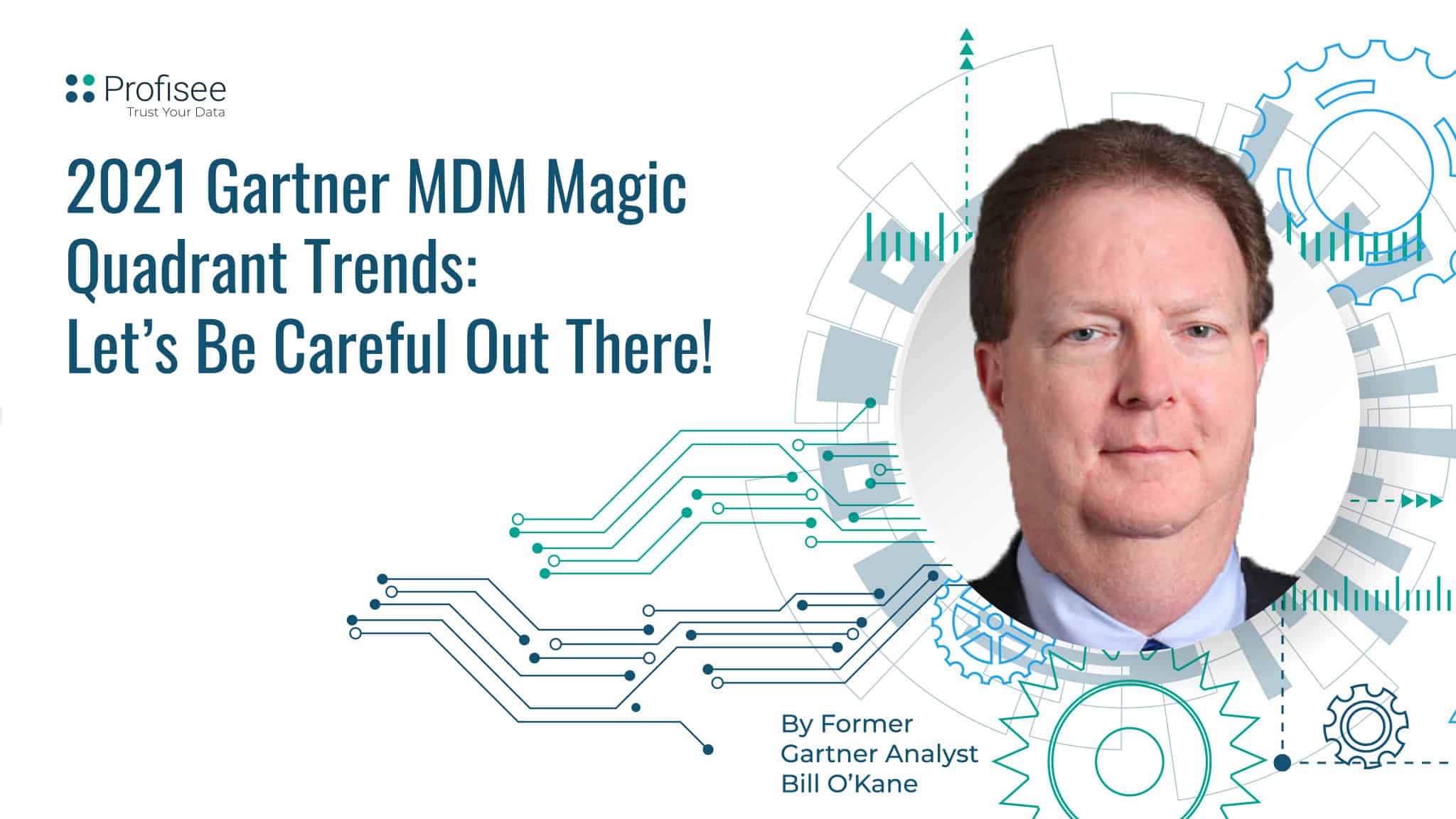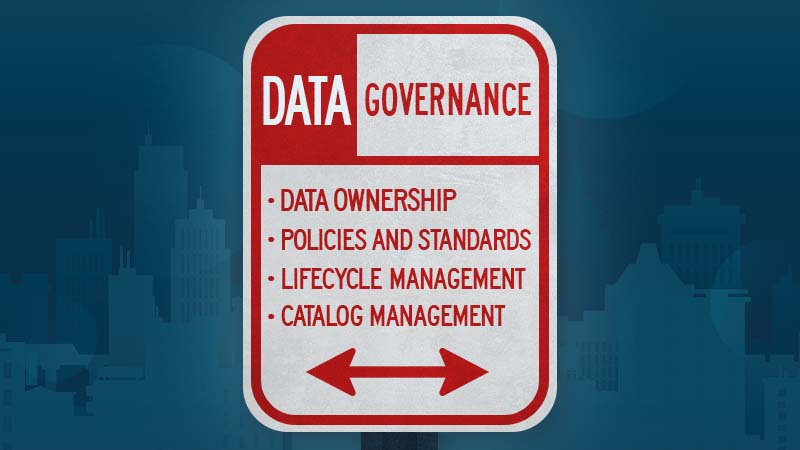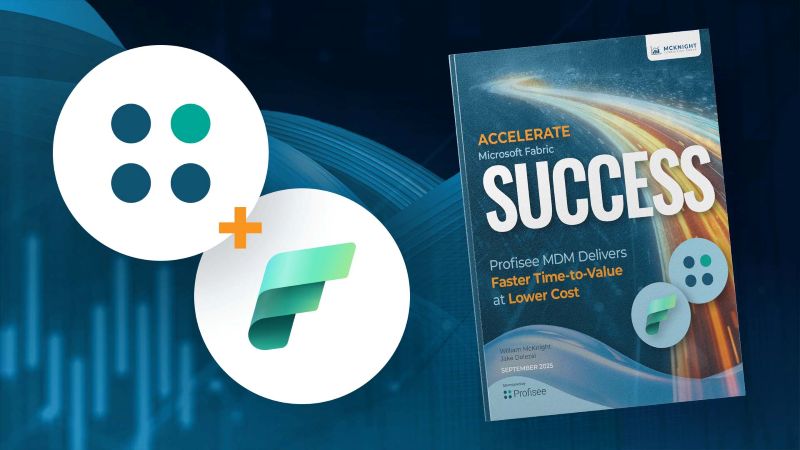Table of Contents
Get the street-level state of the market from former Gartner analyst Bill O’Kane.
The long-awaited 2021 Magic Quadrant for Master Data Management Solutions has arrived! It’s arrived a bit later than expected, likely due to the increased number of MDM Gartner client inquiries (the document cites a 28% YOY growth rate for the period between March and December of 2020) being fielded by the authors. It is an exciting time to be in the world of MDM and my former colleagues at Gartner have produced another informative iteration of this important research that reflects that excitement. Part of that research reveals some of the most interesting MDM market trends to look out for this year.
Gartner’s Four MDM Trends (from my perspective)
- Revenue shifting to the smaller MDM vendors from their larger competitors.
- Barrier to entry with MDM has been lowered, thanks to subscription pricing.
- The increasing trend toward choosing vendors who offer a faster time to value.
- Encroachment of adjacent software market participants on MDM
Key Takeaways for those considering using the 2021 Gartner MDM MQ as an evaluation tool:
- Always consider implementation and adoption costs in addition to software for MDM
- Consider your candidate vendors’ ability and willingness to ensure MDM program success (for example, do they have a team and framework to help you build a business case?), and the degree to which that support may additionally cost you.
- Make sure that you understand how your candidate solutions ensure physical data integrity, especially if they use data storage technology beyond relational databases.
Gartner Magic Quadrant Master Data Management Trends
Trend One: The Rise of the Underdog
Gartner reported that the overall MDM software market grew at a modest pace (1.7% – half of last year’s rate), but this rate increases to 5.6% when IBM and Oracle are removed.
Although revenue shifting to MDM-focused vendors from larger competitors was also a trend last year, this data indicates that this trend is not going anywhere anytime soon. This heavily aligns with our experience at Profisee; the majority of our competitors in the field come from outside the ranks of the mega-vendors.
Trend Two: Subscriptions and Lowering the Cost Barrier
The jury’s in – everyone loves subscriptions. Gartner reports that overall MDM subscription revenue grew by 22.6% for CY2019. This also aligns with our experience at Profisee, as each day more and more clients/prospects inquire or directly request a subscription option.
The subscription trend can likely be attributed indirectly to the rise of the MDM specific vendor vs the mega-vendor. This shift lowers the barrier to entry in terms of initial software costs, making it easier for companies to procure. Keep in mind, however, that just because MDM software is more accessible does not mean that your organization is ready to implement MDM. It is important to remember that you need a strong business case to qualify and quantify data management value creation to be ready. To help you gain full visibility into what being ready for MDM really looks like, I recommend checking out this blog/podcast to get started.
One of the reasons that the lower barrier to purchasing MDM software gives me pause as a larger trend is the increase in Profisee’s business in the past year originating from failed implementations with other vendors (both large and small). While some of them were eventually just too expensive for the buyer to maintain, a good number of them simply could not get off the ground (some technically, some organizationally) after wasting precious time and funding.
Fortunately, we’ve been able to counter these negative experiences in short order, due to our ease of implementation and our business and technical implementation processes and teams. While this is certainly a benefit to Profisee and our clients, as a former industry analyst I personally don’t enjoy learning of unnecessary struggles and outright failures in realizing the transformational value of successful MDM programs.
Trend Three: Faster Times to Value
Gartner has also identified a trend toward faster time to value. This has long been a differentiator for Profisee. Our best-on-class business value consulting team and practices for data management allow us to regularly deliver well-planned initial business value with our platform in three months or less.
We were cited last year as having the most implementations in this category of any MDM vendor. While Gartner correctly states that clients and prospects are often willing to give up overall value for the speed of delivery, we at Profisee have been able to minimize and even eliminate this trade-off at every new client since my arrival eighteen months ago.
Trend Four: Adjacent Software
Perhaps the most interesting development in this year’s research is the encroachment of adjacent software market participants on MDM. These include (but are not limited to):
- CDPs (customer data platforms)
- RDM (reference data management)
- ADM (application data management)
- Augmented Data Catalogs
Unfortunately, while these solutions can fulfill a limited set of use cases (for example, CDPs for marketing requirements), they virtually never have all the important capabilities that an MDM implementation requires. These shortcomings can range from less than robust data modeling, data quality, or data integration capabilities, to the use of data storage mechanisms that may be sufficient for analytical MDM use cases, but that fall short of the transactional integrity required for transactional/operational implementations where MDM is the system of record for one or more data domains. Perhaps adding to the confusion, some MDM vendors have even reacted to this pressure by building some of these ancillary functionalities into their product suites.
Two excellent pieces of research published by Gartner analyst Malcolm Hawker in 2020 are quite helpful in “separating the wheat from the chaff”: How Augmented Data Management Capabilities Are Impacting MDM and Data Governance and Choose Between Customer Data Platforms and MDM Solutions for 360-Degree Customer Insights.
Why Profisee’s Master Data Management Solution?
One of the reasons I joined Profisee after leaving the MDM team at Gartner (and leading several other MDM implementation teams before becoming an analyst) was Profisee’s persistent pursuit of all the things that make MDM implementers successful.
We continue to have the best business value consulting team and processes (known as the Business Impact Roadmap, or BIR) in this business. It is made widely available to both prospects before the sale, as well as clients afterward. Combined with a world-class professional services team and a platform that is extremely easy to implement and expand, this capability has enabled Profisee and our clients to reap the benefits of these trends for several years while ensuring the initial and ongoing success of our clients.
As I’ve said in the past, publishing a Magic Quadrant is a huge amount of work, and as always, I fully appreciate the effort it takes to produce such a quality document. I likely now have what feels like an advantage due to having both the broader market view of the MDM space and (now) a deeper look at what actually happens in the field. I’m especially gratified that Profisee is rated with the highest Ability to Execute in the Challengers quadrant, though I’m having some challenges (given my new perspective) in reconciling the other dot positions in the MQ graphic itself to the details in some of the vendor profiles (which do appear quite accurate). I congratulate my former colleagues on another great achievement.
Download your copy of the 2021 MDM Gartner report.

Bill O'Kane
A former Gartner analyst, Bill O'Kane was the VP & MDM Strategist at Profisee.











